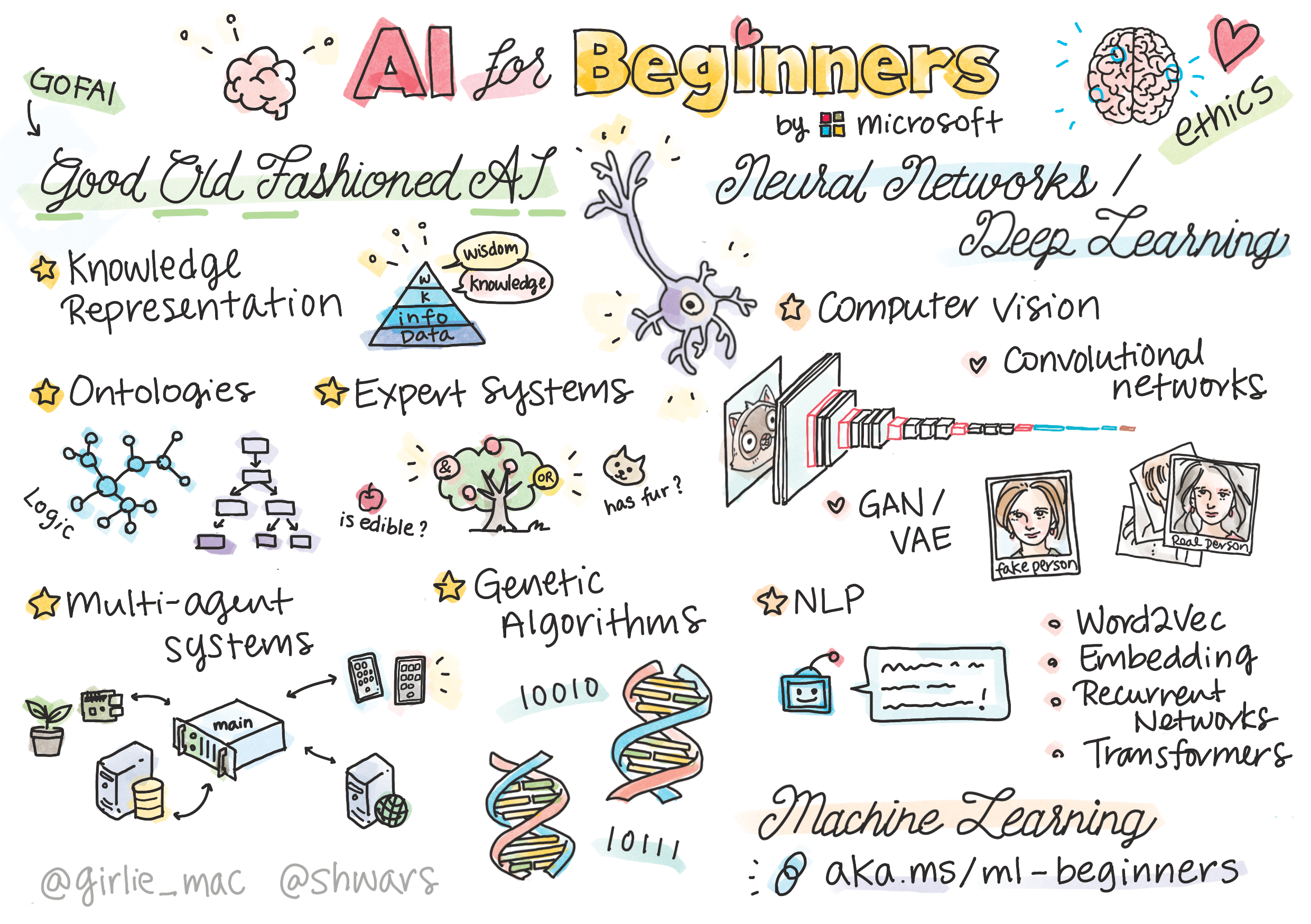AI for Beginners is a 24-lesson-long curriculum available on GitHub under MIT Licence. It is intended both for students and teachers:

- Students can use it to learn basics of AI and Neural Networks. In addition to text-based lessons, you will have executable Jupyter Notebooks with samples, as well as labs that you can do to deepen your knowledge. You can run notebooks either on your local computer or in the cloud.
- Teachers would be able to re-use this material in class, or incorporate some of the samples into their own courses. Also, the course is open for contributions.
About the Course
Despite the name AI for Beginners, this course is not a lightweight introductory course that will give you basic idea of what AI is, and teach how to use Cognitive Services or pre-trained models. It is a full-fledged course on AI, similar to the one that you will learn in the university. We have links to more lightweight courses from AI for Beginners home page, for example AI Fundamentals on Computer Vision and Natural Language. This course is also not about ways AI can be used in business: there is great Introduction to AI for Business users on MS Learn for that.
Some of you may know that I teach a semester-long course on Artificial Intelligence in the university. Materials from that course formed the basis of AI for Beginners.
The main difference between AI for Beginners and a university course is that we tried to make it a bit more applied, and less theoretical, accessible to students without strong mathematical background. This course is definitely not a replacement for a university course, and you should not expect to be able to invent new neural architectures after taking it - but for sure you will be able to use different existing architectures and train complex AI models. Good thing is that without strong mathematics this course should be comprehensible even for high school students (although we have not tried)!
Here is a small sample of what students will be able to learn:

What’s in the Course
AI for Beginners is a text-based course that will introduce you to the topic of AI in general, with special emphasis on Neural Networks and Deep Learning. We provide you with lesson materials and a set of executable Jupyter Notebooks full of content together with some exercises / labs for you to play with.
Unlike many contemporary courses that cover only neural networks and deep learning, we also touch on topics such as knowledge representation and reasoning, multi-agent systems and genetic algorithms, albeit very briefly.

The main topic covered in the curriculum include:
- Overview of AI landscape and different approaches to intelligence.
- GOFAI, symbolic reasoning and knowledge representation.
- Neural networks and Neural frameworks: Tensorflow and PyTorch.
- Computer Vision: from simple convolution networks to object detection and semantic segmentation.
- Natural Language Processing: from simple recurrent networks to modern transformer-based architectures.
- Deep Reinforcement Learning
- Other AI techniques, such as Genetic Algorithms and Multi-Agent Systems
- AI Ethics
Here is complete mindmap of the course
For most of the materials, we provide samples in both PyTorch and TensorFlow. You can chose the framework you are or want to be mostly familiar with.
This curriculum does not include classical Machine Learning - we encourage you to visit our Machine Learning for Beginners Curriculum to learn classical ML algorithms and libraries such as Scikit Learn.
Getting Interactive
One of the things you want to do while learning is to interact with other people. There are several ways you can keep in touch with course authors, as well as other learners:
- For quick communication and discussions, we have set up Telegram Channel
- If you do not use Telegram, there is also a chat on Gitter, which you can use with your GitHub account.
- Feel free to use Discussions on GitHub to post your questions in asynchronous manner.
Credits
This curriculum represents a great effort of our team, and I would like to express my gratitude to people who made this curriculum possible:
- Jen Looper, PhD, who edited the text and managed a lot of aspects of this project
- Tomomi Imura is the person behind beautiful sketchnotes that accompany the curriculum and make it so much more comprehensive, warm and visually pleasing
- Microsoft Learn Student Ambassador community, in particular Lateefah Bello, who reviewed much of the content and created interactive quizzes.
- My students, especially Evgenii Pishchik, who helped authoring some demos and translating code from one framework to another
Want to learn together?
Learning together as a group is definitely more fun! Later this summer or in the fall I am planning to start a Study group for us to learn the material in order, over the period of a couple of months. This study group will be an experiment, to see how we can use this curriculum to implement flipped classroom approach, where you learn the theory at home, and then we get together to discuss.
If you want to be a part of the study group - make sure to join Telegram channel, because that is the place we will post all the announcements.
We need your feedback!
This curriculum is not a book, it is rather a living organism. I am sure the first time we release it, it contains some bugs in the code, as well as some places that are not very clear. Please let us know how we can improve it! And if you find out some of the problem that you can fix yourself, or some content you want to add - feel free to do the pull request, to become co-author of the curriculum!
Also, we would like to welcome any translations of the materials to different languages. Get in touch if you want to contribute!
Happy learning!